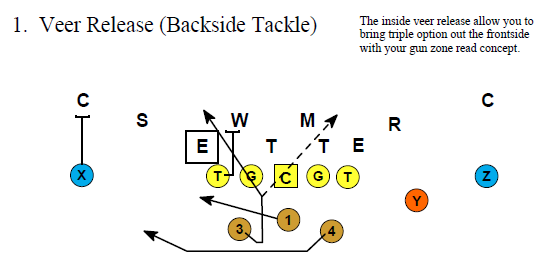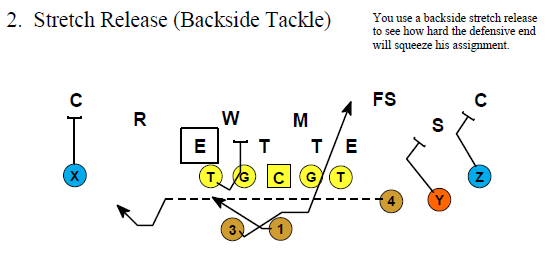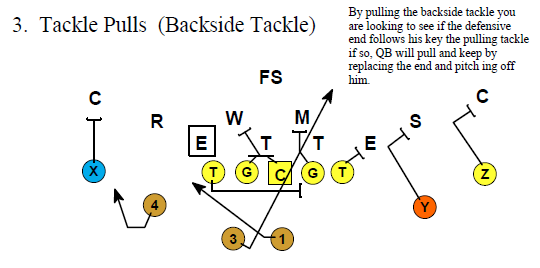The offensive philosophy of the Gun Offense is to spread the defense and control the number of defenders in the box, and limit secondary coverages that your opponent can run, whether from empty, one back, or two back sets. The Gun Offense has been around since the creation of the passing game in 1906, however in recent times the Gun Offense has become one of the most desired offenses being taught today.
The gun had been known primarily as a passing set, but has now grown into a diversified attacking offense, with a full compliment of running plays that gives the quarterback many different options and decisions based upon the reaction of defenders trying to defense the perimeter play. For you coaches that have followed the writings of both Coach Lansdell and myself, we use the Gun Offense to compliment our option game from both under center and from the gun.
As we attempt to install the Gun Offense, we will make every effort to keep the terminology the same as with the other manuals that we have written, so you do not have to start the learning process over. The Gun Offense is exciting because it’s a very simple installation procedure, but at the same time causes a huge degree of difficulty for most defenses. The Gun Offense as explained in this manual becomes a multiple option threat in the running game because of the ability of the quarterback to read backside defensive end (away from the play called). The gun runs will provide multiple reads for defenses to contend with.
This post will take you from the general philosophy of installation and into the running game, play action passing game, sprint out passing game, and then but not least the straight drop back game for the three and five-step attack. As with any option game, whether it be traditional or gun option, the key is to make it simple for your athletes to learn but complex enough to cause your opponents difficulty during the week to prepare for you.
The blocking structure for the Gun Offense is just like the under center “I”Back is built around zone concepts throughout the installation of the running game, which in turn will carry over into the pass protection schemes. Zone blocking concepts are determined by the angle at which the running backs will get the football so, zone footwork for each individual play will be explained in detail which will allow for the easiest explanation to your kids as possible.
The following information is designed to give you the necessary mechanics for installing the gun zone read game. There are many plays and formations for running gun option football but for length and space we have narrowed it down.
The key to installing the gun option game in our opinion is to attack defenses with multiple formations using motion and formation shifts. Motion and formation shifts are used to gain a numbers advantage, always keep one more offensive threat then defenders have to stop any given gun option play. As you read this manual you will find that we have put our quarterback in a position of reading inverts and defensive ends for best play, its like having a 12th man on the field.
When installing the zone read you should try and establish a game plan that allows you to run all your options out of all your different formations and not just limit yourself to a few plays on any given formation, because this creates tendencies. Also, remember the gun option game forces defenses to play assignment football, a defense might carry out that assignment correctly one, two, three, four, or even five times in a row, its that sixth time one defender makes a mistake and its six points. You must establish patience early in a game with any zone read attack, your players must get comfortable with their reads and mesh points. Not all plays that you call will be long gainers or touchdowns so, keep in mind when running a zone read offense, you’re always only one play away from making the 85 yard touchdown run.
Combining The “I” Back Offense with The Gun Offense is built around three primary concepts. First, two-back formations, secondly, one-back sets and third, the dropback passing game. All of the other plays in this manual will be considered secondary schemes used as a change up to these three primary options.
It has always been our contention, that if you as a coach have a systematic way to install your offense, then your players have a systematic way of learning it. We build a lot of the offense around our quarterback keeping us in the best possible play for the blocking schemes that we install. This is done by reading outside inverts and defensive ends or 5 techniques for best play and then changing that play on the line of scrimmage. As the gun option game is installed we like to try and pair plays, meaning that, if we call a play in the huddle and the quarterback comes to the line of scrimmage and sees that the defense is giving us a defensive front alignment that doesn’t fit the play then our quarterback can audible us into a play that does fit the defensive scheme. We want to keep our offensive line in the best possible position for success and keep the mechanics of the play smooth.
GUN OFFENSE – RUN
Installing The Gun Zone Read Runnning Game
The gun zone read running game is built around the same concepts as a true option game except the read is coming from the opposite side the play is being called. As you learn and study the installation of the gun zone read you will find many different scenarios in which to take advantage of defenses trying to defense not only the front side of the play but the backside also. The gun option game creates opportunities in which to spread defenses and to create gaps in the defensive box. Your gun zone read gives defenders a lot of cross key responsibilities to work on when preparing for the misdirection opportunities the gun running game presents.
Whenever running the gun from a one back set, the running game will create a double option possibility according to the reaction of the backside end man on the line of scrimmage E.M.L.O.S.
The key for the quarterback giving the ball to the running back is the reaction of the E.M.L.O.S. The quarterback must be able to see how the end reacts to the offensive tackle or tight end on the backside, whether on an inside veer release or pull trying to get playside for his running back. If the defensive end plays down and inside to the reaction of the tackle it probably means that he’s playing the run. This is where the quarterback would pull the ball out from the mesh of the running back and keep it and try and replace the defensive end on the outside by running upfield. If the E.M.L.O.S. plays up the field means that the E.M.L.O.S. has a responsibility to defend the quarterback so the ball is handed off. By the E.M.L.O.S. defending the quarterback on the gun option read he has now been accounted for and you have gained an additional blocker for the box.
Quarterback read for best decision on giving the ball or keeping the ball in a one back gun zone read attack is based upon the invert or defensive end. Remember, the quarterback is reading the end for give or keep read but, the decision to put this into an option read play is because of the outside invert.
In the next situation, with the outside invert located outside of the EMLOS the quarterback would make the decision to give the ball and you would probably not want to read this particular run play. The key to keep it as a read option play would be to bring another receiver over to block the outside invert. Thus, taking the quarterback player out of the game.
With the two back gun you have a triple zone read threat as shown below. The key is to get a two on three situation. The quarterback would read the play of the E.M.L.O.S. for best zone.
The running back that gets the callside zone read or give possibility must provide a good mesh pocket for with the quarterback to ride the ball. The running back, if not given the ball, must carry out a great fake – be an actor.
The center quarterback gun exchange needs to be perfected for best results. The center should always work to snap the ball at the belt buckle of the quarterback. Several different formations, motions, and secondary blocking schemes can be used to incorporate best option
plays for the quarterback, use your imagination here.
Challenge Defense with 3 backside set-ups (Zone Reads)



About the Author of this post:
Jerry Campbell has over 30 years of high school and college coaching experience. He has experience as a head coach, offensive coordinator, and various position coaches. He has written numerous football coaching articles in various publications, is the author of over 30 books on coaching football, and has produced 12 coaching video series. Additionally, he is a nationally sought after speaker on the coaching clinic circuit.